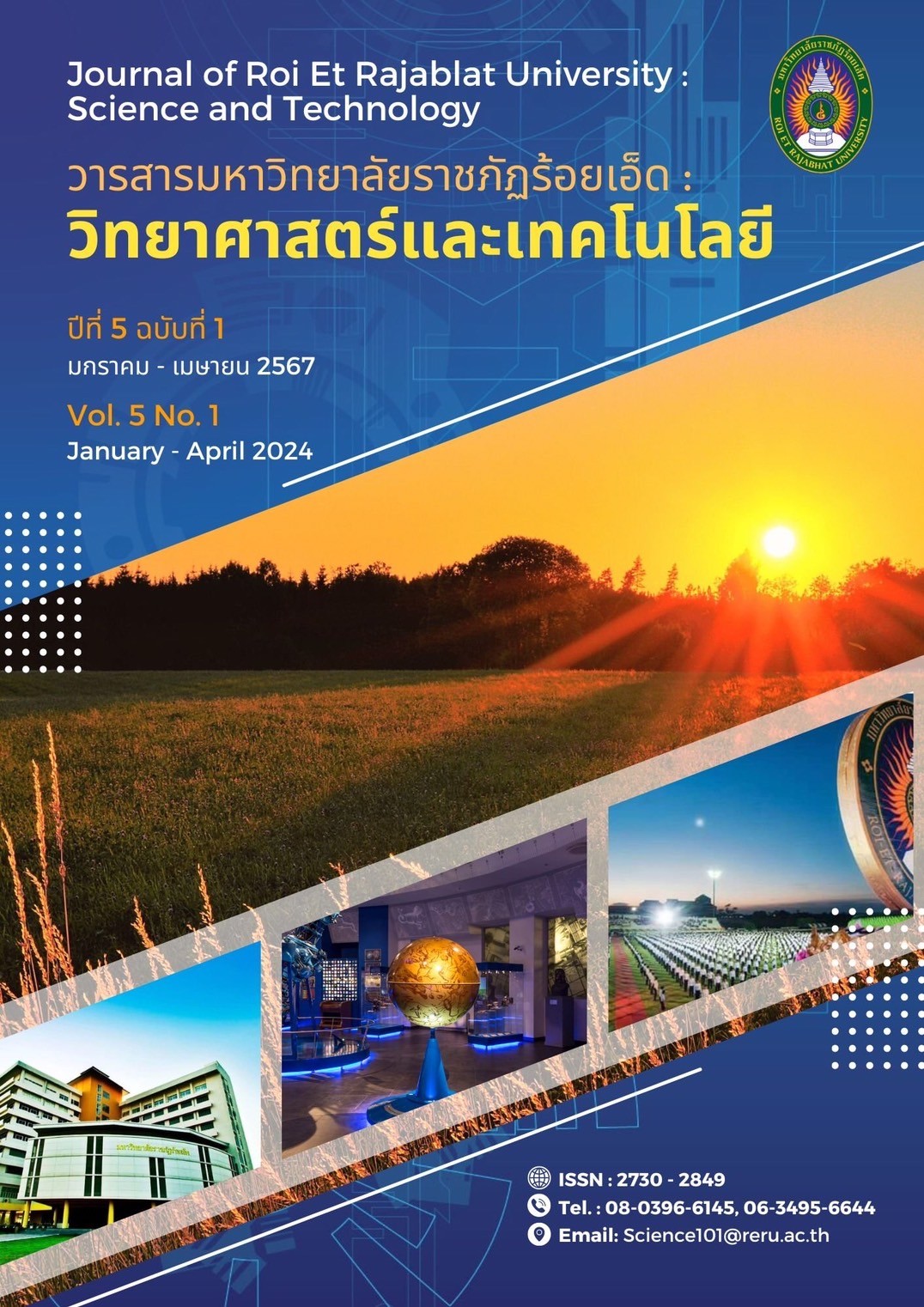การใช้วัสดุเหลือใช้จากพืชวงศ์กัญชาเป็นทางเลือกในการควบคุมลูกน้ำยุงลายบ้าน
คำสำคัญ:
สารสกัดจากวัสดุเหลือใช้จากพืชวงซ์กัญชา, ลูกน้ำยุงลายบ้าน, การทดสอบความเป็นพิษบทคัดย่อ
ยุงลายบ้านเป็นยุงพาหะหลักที่นำโรคไข้เลือดออกซึ่งเป็นปัญหาทางสาธารณสุขที่สำคัญในประเทศไทย ตั้งแต่อดีตจวบจนปัจจุบันนั้นได้พยายามมีการประยุกต์ใช้สารเคมีจากสารสกัดจากพืชมาเป็นทางเลือกในการควบคุมยุงพาหะ ซึ่งการวิจัยในครั้งนี้มีวัตถุประสงค์เพื่อทดสอบฤทธิ์ของสารสกัดหยาบจากวัสดุเหลือใช้จากพืชวงศ์กัญชาที่สกัดด้วยเฮกเซน และเมทานอล ต่อลูกน้ำยุงลายบ้านในวัยที่ 3-4 ด้วยการเตรียมสารที่ความเข้มข้นแตกต่างกัน (0, 125, 250, 500 และ 1,000 มิลลิกรัม/ลิตร) และอัตราการตายที่ 24 ชั่วโมง พบว่า สารสกัดจากวัสดุเหลือใช้จากพืชวงศ์กัญชาที่สกัดด้วยเฮกเซน มีอัตราการตายสูงถึง 98.00% และมีค่า LC50 ต่อลูกน้ำยุงลายบ้าน ที่ 24 ชั่วโมงภายหลังการทดสอบ เท่ากับ 13.120 มิลลิกรัม/ลิตร ในขณะที่อัตราการตายของลูกน้ำยุงลายบ้านจากสารสกัดด้วยเมทานอลมีค่าเท่ากับ 88.00% และมีค่า LC50 เท่ากับ 67.059 มิลลิกรัม/ลิตร ทั้งนี้พบว่า สารสกัดที่สกัดด้วยตัวทำลายทั้งสองสารให้ผลการตายของลูกน้ำยุงลายบ้านที่ไม่แตกต่างกัน (p ≥ 0.05) โดยสารสกัดจากวัสดุเหลือใช้จากพืชวงศ์กัญชาในครั้งนี้สามารถนำไปใช้ในการป้องกันควบคุมลูกน้ำยุงลายบ้านรวมทั้งแมลงอื่น ๆ ที่เป็นปัญหาทางสาธารณสุขในพื้นที่เสี่ยงต่อไปได้
เอกสารอ้างอิง
Abbott, W. S. (1925). A method of computing the effectiveness of an insecticide. Journal of Economic Entomology, 8, 265–267. https://doi.org/10.1093/jee/18.2.265a
Benedict, K., Thompson, G. R., 3rd, & Jackson, B. R. (2020). Cannabis Use and Fungal Infections in a Commercially Insured Population, United States, 2016. Emerging infectious diseases, 26(6), 1308–1310. https://doi.org/10.3201/eid2606.191570
Benelli, G., Pavela, R., Lupidi, G., Nabissi, M., Petrelli, R., Ngahang Kamte, S. L., Cappellacci, L., Fiorini, D., Sut, S., Dall'Acqua, S., & Maggi, F. (2018). The crop-residue of fiber hemp cv. Futura 75: from a waste product to a source of botanical insecticides. Environmental science and pollution research international, 25(11), 10515–10525. https://doi.org/10.1007/s11356-017-0635-5
Dhar-Chowdhury, P., Paul, K. K., Haque, C. E., Hossain, S., Lindsay, L. R., Dibernardo, A., Brooks, W. A., & Drebot, M. A. (2017). Dengue seroprevalence, seroconversion and risk factors in Dhaka, Bangladesh. PLoS neglected tropical diseases, 11(3), e0005475. https://doi.org/10.1371/journal.pntd.0005475
Ghosh, A., Chowdhury, N. & Chandra, G. (2012). Plant extracts as potential mosquito larvicides. The Indian Journal of Medical Research 135, 581–598. https://www.ncbi.nlm.nih.gov/pmc/articles/PMC3401688/pdf/IJMR-135-581.pdf
Finney. D. J. (1971). Probit Analysis. 3rd Edition, Cambridge University Press, Cambridge.
https://doi.org/10.1002/jps.2600600940
Hourfane, S., Mechqoq, H., Bekkali, A. Y., Rocha, J. M., & El Aouad, N. (2023). A Comprehensive Review on Cannabis sativa Ethnobotany, Phytochemistry, Molecular Docking and Biological Activities. Plants (Basel, Switzerland), 12(6), 1245. https://doi.org/10.3390/plants12061245
IBM Crop. (2017). IBM SPSS Statistics for Windows, Version 25.0. Armonk, NY: IBM Crop.
Im-iam, S., Saensanor, S., Sukcharoen, P. and Sawasdichai, C. (2019). Cannabis. The Journal of Prapokklao Hospital Clinical Medical Education Center. 36(4), 356–362. https://he02.tci-thaijo.org/index.php/ppkjournal/article/view/228729/155657
Leme, F. M., Borella, P. H., Marinho, C. R. & Teixeira, S. P. (2020). Expanding the laticifer knowledge in Cannabaceae: distribution, morphology, origin, and latex composition. Protoplasma, 257(4), 1183–1199. https://doi.org/10.1007/s00709-020-01500-5
Lewis, M. M., Yang, Y., Wasilewski, E., Clarke, H. A. & Kotra, L. P. (2017). Chemical profiling of Medical Cannabis Extracts. ACSOmega, 2, 6091−6103. https://pubs.acs.org/journal/acsodf
McPartland, J. & Sheikh, Z. (2018). A review of Cannabis sativa-based insecticides, miticides, and repellents. Journal of Entomology and Zoology Studies, 6, 1288–1299. https://www.entomoljournal.com/archives/2018/vol6issue6/PartV/6-6-173-373.pdf
Nantakonpreda, N., Naisaen, S., Tunruen, K., Poolprasert, P., Srisayam, M., Phothong, D. and Trongtokit, Y. (2017). Larvicidal property of wood vinegar extract of Annona squamosa seed against Aedes aegypti mosquito. PSRU Journal of Science and Technology, 2(3): 33-40. https://ph01.tci-thaijo.org/index.php/Scipsru/article/view/105055/85219
Ona, G., Balant, M., Bouso, J. C., Gras, A., Vallès, J., Vitales, D., & Garnatje, T. (2022). The Use of Cannabis sativa L. for Pest Control: From the Ethnobotanical Knowledge to a Systematic Review of Experimental Studies. Cannabis and cannabinoid research, 7(4), 365–387. https://doi.org/10.1089/can.2021.0095
Protti, M., Brighenti, V., Battaglia, M. R., Anceschi, L., Pellati, F. & Mercolini, L. (2019). Cannabinoids from Cannabis sativa L.: A New Tool Based on HPLC-DAD-MS/MS for a Rational Use in Medicinal Chemistry. ACS medicinal chemistry letters, 10(4), 539–544. https://doi.org/10.1021/acsmedchemlett.8b00571
Rahman, M. S., Faruk, M. O., Tanjila, S., Sabbir, N. M., Haider, N., and Chowdhury, S. (2021). Entomological survey for identification of Aedes larval breeding sites and their distribution in Chattogram, Beni-Suef University Journal of Basic and Applied Sciences, 10, 1–11. https://doi.org/10.1186/s43088-021-00122-x
Rogers, K. (2023, June 22). Aedes. Encyclopedia Britannica. https://www.britannica.com/animal/Aedes
Rossi, P., Cappelli, A., Marinelli, O., Valzano, M., Pavoni, L., Bonacucina, G., Petrelli, R., Pompei, P., Mazzara, E., Ricci, I., Maggi, F., & Nabissi, M. (2020). Mosquitocidal and Anti-Inflammatory Properties of The Essential Oils Obtained from Monoecious, Male, and Female Inflorescences of Hemp (Cannabis sativa L.) and Their Encapsulation in Nanoemulsions. Molecules (Basel, Switzerland), 25(15), 3451. https://doi.org/10.3390/molecules25153451
Suryavanshi, S. V., Kovalchuk, I., & Kovalchuk, O. (2021). Cannabinoids as Key Regulators of Inflammasome Signaling: A Current Perspective. Frontiers in immunology, 11, 613613. https://doi.org/10.3389/fimmu.2020.613613
Tabari, M. A., Khodashenas, A., Jafari, M., Petrelli, R., Cappellacci, L., Nabissi, Maggi, F. Pavela, R. & Youssefi, M.R. (2020). Acaricidal properties of hemp (Cannabis sativa L.) essential oil against Dermanyssus gallinae and Hyalommadrome darii. Industrial Crops and Product, 147, 112238. https://doi.org/10.1016/j.indcrop.2020.112238
Tongkasee, P. & Srithat, D. (2022). Chemical Profile of Crude Extracts from Cannabis sativa L. dried stems with Gas Chromatography Techniques. Journal of Cannabis, Hemp and Herbs, 1(1), 9-15. https://he01.tci-thaijo.org/index.php/JCHH/article/view/255287/172748
ดาวน์โหลด
เผยแพร่แล้ว
รูปแบบการอ้างอิง
ฉบับ
ประเภทบทความ
สัญญาอนุญาต
ลิขสิทธิ์ (c) 2024 คณะศิลปศาสตร์และวิทยาศาสตร์ มหาวิทยาลัยราชภัฏร้อยเอ็ด

อนุญาตภายใต้เงื่อนไข Creative Commons Attribution-NonCommercial-NoDerivatives 4.0 International License.
บทความที่ได้รับการตีพิมพ์เป็นลิขสิทธิ์ของคณะศิลปศาสตร์และวิทยาศาสตร์ มหาวิทยาลัยราชภัฏร้อยเอ็ด
ข้อความที่ปรากฏในบทความแต่ละเรื่องในวารสารวิชาการเล่มนี้เป็นความคิดเห็นส่วนตัวของผู้เขียนแต่ละท่านไม่เกี่ยวข้องกับมหาวิทยาลัยราชภัฎร้อยเอ็ด และคณาจารย์ท่านอื่นๆในมหาวิทยาลัยฯ แต่อย่างใด ความรับผิดชอบองค์ประกอบทั้งหมดของบทความแต่ละเรื่องเป็นของผู้เขียนแต่ละท่าน หากมีความผิดพลาดใดๆ ผู้เขียนแต่ละท่านจะรับผิดชอบบทความของตนเองแต่ผู้เดียว






